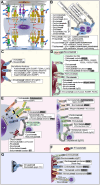Therapeutic antibodies in oncology: an immunopharmacological overview
- PMID: 39358613
- PMCID: PMC11448508
- DOI: 10.1007/s00262-024-03814-2
Therapeutic antibodies in oncology: an immunopharmacological overview
Abstract
The biotechnological development of monoclonal antibodies and their immunotherapeutic use in oncology have grown exponentially in the last decade, becoming the first-line therapy for some types of cancer. Their mechanism of action is based on the ability to regulate the immune system or by interacting with targets that are either overexpressed in tumor cells, released into the extracellular milieu or involved in processes that favor tumor growth. In addition, the intrinsic characteristics of each subclass of antibodies provide specific effector functions against the tumor by activating antibody-dependent cellular cytotoxicity, complement-dependent cytotoxicity, and antibody-dependent cellular phagocytosis, among other mechanisms. The rational design and engineering of monoclonal antibodies have improved their pharmacokinetic and pharmacodynamic features, thus optimizing the therapeutic regimens administered to cancer patients and improving their clinical outcomes. The selection of the immunoglobulin G subclass, modifications to its crystallizable region (Fc), and conjugation of radioactive substances or antineoplastic drugs may all improve the antitumor effects of therapeutic antibodies. This review aims to provide insights into the immunological and pharmacological aspects of therapeutic antibodies used in oncology, with a rational approach at molecular modifications that can be introduced into these biological tools, improving their efficacy in the treatment of cancer.
Keywords: Antibody-drug conjugates; Bispecific T-cell engagers (BiTEs); Bispecifics; Cancer therapy; Immunobiotechnology; Immunotherapy; Monoclonal antibodies.
© 2024. The Author(s).
Conflict of interest statement
The authors declare no competing interests.
Figures


References
-
- GLOBOCAN (2021) World Health Organization: Global cancer statistics 2020 report. (http://globocan.iarc.fr/)
-
- Grillo-López AJ (2002) Monoclonal antibody therapy for B-cell lymphoma. Int J Hematol 76:385–393. 10.1007/bf02982803 - PubMed
-
- The_Antibody_Society (2024) Therapeutic monoclonal antibodies approved or in regulatory review. www:antibodysociety.org/antibody-therapeutics-product-data. Accessed 15 May 2024
Publication types
MeSH terms
Substances
Grants and funding
- 3230454/Agencia Nacional de Investigación y Desarrollo
- 3240175/Agencia Nacional de Investigación y Desarrollo
- 3220181/Agencia Nacional de Investigación y Desarrollo
- Scholarship 21221729/Agencia Nacional de Investigación y Desarrollo
- Scholarship 21231772/Agencia Nacional de Investigación y Desarrollo
LinkOut - more resources
Full Text Sources
Medical

